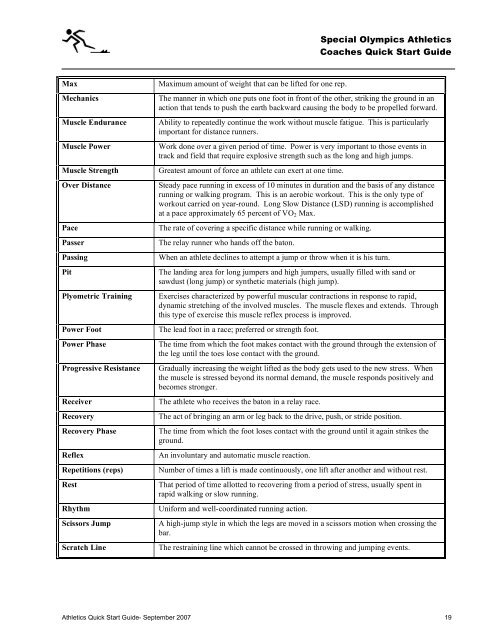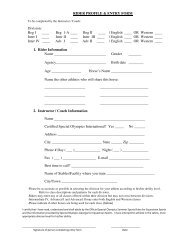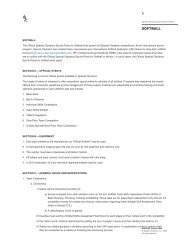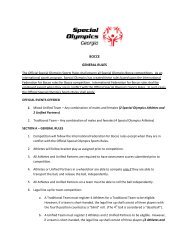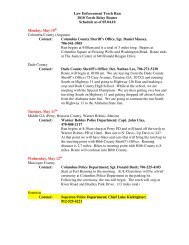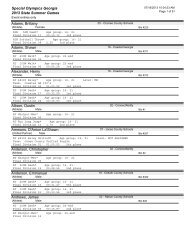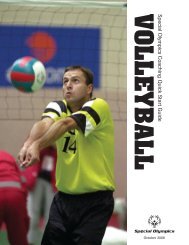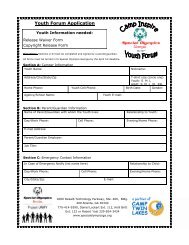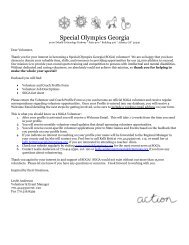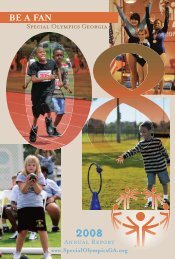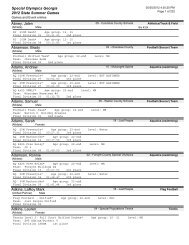Athletics Quick Start Guide - Special Olympics
Athletics Quick Start Guide - Special Olympics
Athletics Quick Start Guide - Special Olympics
You also want an ePaper? Increase the reach of your titles
YUMPU automatically turns print PDFs into web optimized ePapers that Google loves.
<strong>Special</strong> <strong>Olympics</strong> <strong>Athletics</strong><br />
Coaches <strong>Quick</strong> <strong>Start</strong> <strong>Guide</strong><br />
Max<br />
Mechanics<br />
Muscle Endurance<br />
Muscle Power<br />
Muscle Strength<br />
Over Distance<br />
Pace<br />
Passer<br />
Passing<br />
Pit<br />
Plyometric Training<br />
Power Foot<br />
Power Phase<br />
Progressive Resistance<br />
Receiver<br />
Recovery<br />
Recovery Phase<br />
Reflex<br />
Repetitions (reps)<br />
Rest<br />
Rhythm<br />
Scissors Jump<br />
Scratch Line<br />
Maximum amount of weight that can be lifted for one rep.<br />
The manner in which one puts one foot in front of the other, striking the ground in an<br />
action that tends to push the earth backward causing the body to be propelled forward.<br />
Ability to repeatedly continue the work without muscle fatigue. This is particularly<br />
important for distance runners.<br />
Work done over a given period of time. Power is very important to those events in<br />
track and field that require explosive strength such as the long and high jumps.<br />
Greatest amount of force an athlete can exert at one time.<br />
Steady pace running in excess of 10 minutes in duration and the basis of any distance<br />
running or walking program. This is an aerobic workout. This is the only type of<br />
workout carried on year-round. Long Slow Distance (LSD) running is accomplished<br />
at a pace approximately 65 percent of VO 2 Max.<br />
The rate of covering a specific distance while running or walking.<br />
The relay runner who hands off the baton.<br />
When an athlete declines to attempt a jump or throw when it is his turn.<br />
The landing area for long jumpers and high jumpers, usually filled with sand or<br />
sawdust (long jump) or synthetic materials (high jump).<br />
Exercises characterized by powerful muscular contractions in response to rapid,<br />
dynamic stretching of the involved muscles. The muscle flexes and extends. Through<br />
this type of exercise this muscle reflex process is improved.<br />
The lead foot in a race; preferred or strength foot.<br />
The time from which the foot makes contact with the ground through the extension of<br />
the leg until the toes lose contact with the ground.<br />
Gradually increasing the weight lifted as the body gets used to the new stress. When<br />
the muscle is stressed beyond its normal demand, the muscle responds positively and<br />
becomes stronger.<br />
The athlete who receives the baton in a relay race.<br />
The act of bringing an arm or leg back to the drive, push, or stride position.<br />
The time from which the foot loses contact with the ground until it again strikes the<br />
ground.<br />
An involuntary and automatic muscle reaction.<br />
Number of times a lift is made continuously, one lift after another and without rest.<br />
That period of time allotted to recovering from a period of stress, usually spent in<br />
rapid walking or slow running.<br />
Uniform and well-coordinated running action.<br />
A high-jump style in which the legs are moved in a scissors motion when crossing the<br />
bar.<br />
The restraining line which cannot be crossed in throwing and jumping events.<br />
<strong>Athletics</strong> <strong>Quick</strong> <strong>Start</strong> <strong>Guide</strong>- September 2007 19


